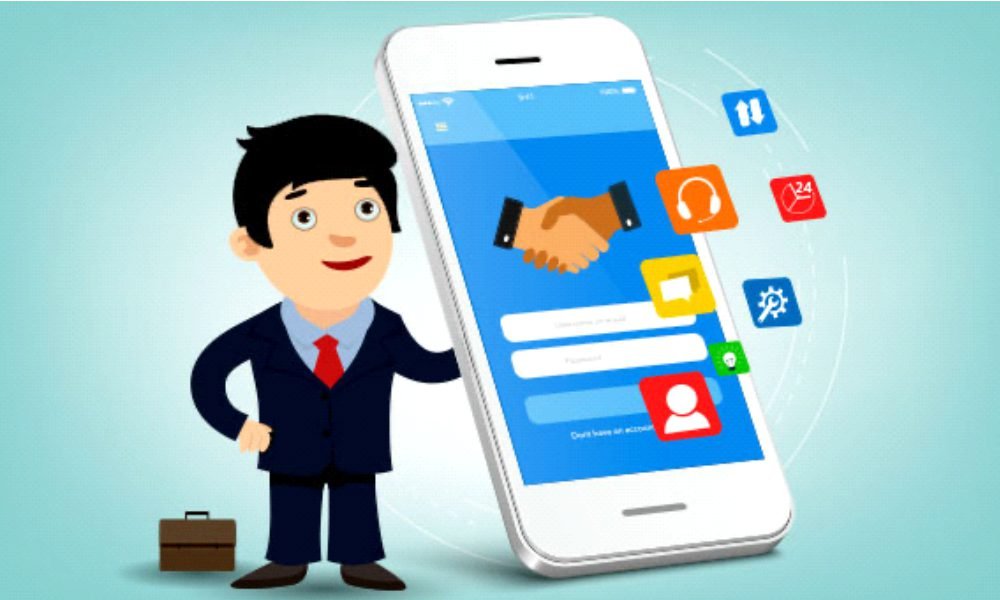Why should a business hire a mobile app developer? Highlights:
Increase sales
Apps make shopping from mobile devices much more convenient, which boosts sales.
Attracting customers
Informing customers about discounts, promotions, and other bonuses will encourage them to make repeat purchases, and new ones will simply be interested. Loyalty programs, and transferring the bonus card to the smartphone will all win the heart of the user.
Continuous communication with the customer
The app helps the company not only in sales, but also in communication with the customer, which becomes almost continuous, and as simplified as possible.
Gathering information about the audience
Thanks to app usage statistics, the company gets to know its target audience better. The rare uninterested user will go to the app and keep it on their device at all. The business will need the information obtained for its further promotion.

How to understand that your business needs an app
The challenges are many, and it’s up to each brand to choose which one they need. But how do you know if a business basically needs an app? Not every business needs an app, but it’s not always immediately clear. Sometimes the realization comes too late when the money for development and promotion is gone and the tasks are still unresolved.
Before looking for a mobile app developer, ask yourself a few questions, the answers to which will put you on the right track.
Is your site being accessed via cell phone?
These days, it’s easy enough to track these numbers through Google Analytics. Look at the ratio of those who visit the site via desktop to mobile devices.
One common marker for the need for an app is that most visitors to your site access it via mobile. Or they use it to scan QR codes in your store. If a customer is already using a cell phone to communicate with you or your competitors, that’s a clear signal for action.
However, there are also many completely unobvious examples where a mobile app has led to business growth even though there was no obvious prerequisite for it.
Do you use a loyalty program?
Not only does an app make a business mobile, but it also frees the wallet from plastic cards. Think about what you can offer the customer as a loyalty system. Do you have a rewards card that can be transferred?
Are there a lot of apps in your niche?
We’re talking about competitors here. If there are (and there are), research them more. Look at their reviews, ratings, and number of downloads. Analyze the functionality and content of the app.
What new features will the app provide?
Think about what the app can give that the existing site doesn’t. If you decide that using a mobile app will become more convenient for users, then feel free to order the development. Constant reminders about yourself, promotions and other bonuses, automating the process, and supporting regular clients — a mobile app beats the site in this regard.
Stages
- Idea and analytics.
- Terms of reference.
- Design.
- Development.
- Testing.
- Publishing.
- Support and development.
- Idea and analytics
Determine why you need the app and what problems it will solve. This information should be given to the mobile app developers, who will do thorough research so that your app won’t become another one that just takes up your phone’s memory.
Usually, the work of creating an app goes like this. A client comes in and fills out a brief to determine the main tasks. The brief should include information about the company, the mobile app, and additional details about the project. The company information includes name and contact details, organization name and website, the field of activity, and main products or services.
Information about the mobile application is everything that concerns your project. For example, the purpose of creating the app, a description of the target audience and competitors, the choice of platforms for which you want to make the app, and the type, structure, and functionality of the solution.
Additional data about the project include things that are not included in the main sections of the brief, but that are important to tell. For example, the wishes regarding the timing, the approach to development, and the interaction between the mobile app developers and the customer.
After the receipt of the brief, the details of the collaboration are discussed with the client. Next, work on the creation of the application begins. The specialists analyze the market and competitors who are solving similar problems to yours, the target audience and their needs, as well as other factors. This stage takes a lot of time, but if done well, it will save you money.

Terms of Reference
Together with the customer, detailed terms of reference are prepared, which are then passed on to the designers and mobile app developers. It specifies the app’s functions, interface design, and user behavior (stories and journey maps).
User stories and the journey map are a kind of path that users of different categories take in one way or another, starting from downloading the app. Professionals must route the customer in a way that makes the app as convenient and functional as possible.
It is worth noting that each firm engaged in application development draws up the ToR according to its own criteria. Usually, they consist of general points and functional and non-functional requirements. The latter include security, performance, and other aspects.
Design
UX and UI designers are in charge of design development. The UX designer is a kind of marketer who studies user behavior, comes up with user-friendly interface schemes, tests the application, and prepares the terms of reference for the UI designer.
The UI designer is responsible for the appearance of the interface — forms, buttons, icons, and other components. They were also responsible for developing the voice and sound interface. Often a single specialist — the UX/UI designer, handles these processes.
Developing
After the designers have worked on the appearance of the application, programmers make the application work. Usually, a test version of the app is created first.
Testing
Testing is done to make sure that the app works perfectly. This helps to detect bugs before the official release.
It is customary to divide two types of testing:
- Alpha testing. When mobile app developers themselves check all the work of the application still in the development stage or after its completion.
- Beta-testing. When a special audience tests an application. A certain circle of people is given an opportunity to test the application as ordinary users. Any bugs found are reported to mobile app developers.
Alpha-testing is a more efficient way of testing an application for bugs, because mobile app developers check the code itself. The target audience finds the remaining bugs already.
As a result, the bugs are fixed and the application is stabilized for the official release in the storerooms.
Publishing
At the moment, the most popular app stores are the App Store and Google Play Market.
Support and development
If an app is simply published and forgotten about, it will become uncompetitive after a while. To stay competitive, you need to keep developing the app and updating it.
How long does mobile app development take
If it is a large and voluminous project, it may take 3-4, but IT products should be brought to market and tested as early as possible. Here it all depends on the complexity of the work. It is possible to customize a typical solution in a month, while it takes at least half a year to write code from scratch.
On average, it takes from 1 to 5 months to create an application. The time depends on the complexity of the task and on how clear the idea and the necessary requirements were initially formulated. To minimize situations where the project concept itself changes during the development process, you need to be meticulous about collecting analytics and drafting the terms of reference. In the end, this helps to save time and money for the client.
Also Read: How Mobile Apps are Changing the Finance Industry?















